To the right is an animated gif of the various slices of the eclipse (I delayed the time in the middle where the red Moon showed through the clouds). There are some gaps at the end - because of the CLOUDS - Doh!!

I took about three rolls of film - but fought the clouds all the way. This was my first photo-op for an eclipse, so I stuck with a single zoom lens (400 mm) .. I have "doubler" lenses that I could have added, but didn't know exactly how that would affect the exposure times, so I decided to try for smaller/successful rather than larger/ruined for my first attempt.
|
To the right is an animated gif of the various slices of the eclipse (I delayed the time in the middle where the red Moon showed through the clouds). There are some gaps at the end - because of the CLOUDS - Doh!! |
 |
Using a small handheld micro-cassette recorder, I tried to record the exposure times/settings (as well as the time of day). Just a little tidbit : At 11:03 PM, it was time for Tomato Soup!!! (You can hear the relief in my voice!)
As I looked up in the sky, the Moon was moving from East to West, as expected .. but we can see that relative to the shadow from the Earth, the Moon would move from West to East (so we will see the shadow bite into the left side of the Moon .. then leave on the right side of the Moon).Below is a montage of all the images :
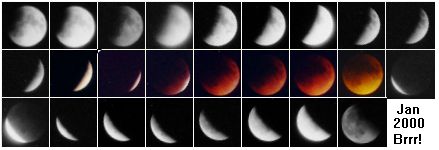
|
You can get a rough idea of the size of the Earth shadow by comparing early images to later images (and stick one of the "totality" images in the middle). This is very rough (I was not keeping the orientation of the camera fixed - so I "fudged" the rotations of these images slightly by eye) - enough to give us an indication .. on future eclipses, I could perfect the technique. In the image to the right .. the Moon is going from right to left (relative to the shadow of the Earth) - there is a faint line showing the rough shape/position of the Earth's shadow that the Moon passed into. |
|
|
Here is a collection to show the behind the scenes to get the images above. To the right is what the sky often looked like - doh! To the bottom left is a shot of me gazing upward trying to will the clouds away .. next to me is the zoom lens (with a heater cuff on the end). To the bottom right is the hearty photographer calling it quits (with all his equipment) a little after 1:30 AM! |
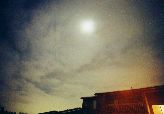 |
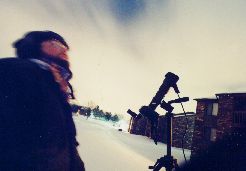 |
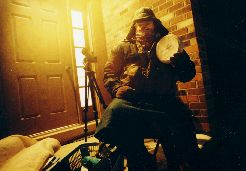 |
Now here is some background on what the eclipse was all about (and you can see a more professional image of the Earth shadow information in the next image) :
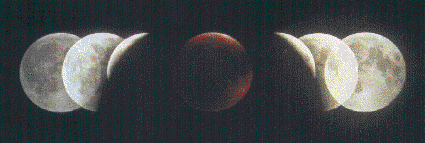
What is it? Weather permitting, we will see a total Lunar eclipse from about 10:00 PM Thursday Jan 20th to 1:25 AM on Friday Jan 21st, 2000.
How does it work (what is a lunar eclipse)? One face of the Earth always faces the Sun, and thus there is a "shadow" from the Earth that points outward into space on the opposite side from the Sun. The shadow lies in the Earth-Sun orbital plane. The moon has an orbit that is plane that tilts just slightly with respect to the Earth-Sun plane. Occasionally, the Moon will cross the Earth-Sun plane (twice an orbit) - and even more rarely, it will make that pass when the Earth's shadow is there (causing the light from the Sun to be blocked by the Earth). [The Moon can also touch the Earth-Sun plane between the Earth and the Sun - causing a Solar Eclipse.] Notice that the adjective in front of the word eclipse tells what object is being "blocked" ... a lunar eclipse has the Earth blocking the light to the Moon and a solar eclipse has the Moon blocking the light from the Sun.
What does the geometry look like? Here is a drawing of what the
lunar eclipse looks like: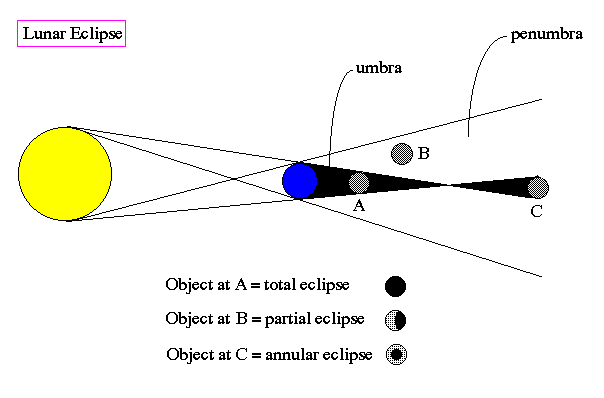
What are the types of lunar eclipses? As shown above, there are three types .. total, partial, annular. There are two types of shadow areas behind the Earth .. the Umbra is the area where the sun cannot be seen at all (Moon A above) .. the Penumbra is the area where part of the Sun can be seen, but the Earth is blocking the rest (Moon B above). If the Moon's path only takes it through the penumbra and it never gets completely into the umbra phase, then it is a Partial Eclipse. If the Moon can get completely into the Umbra phase, then it will be a Total Eclipse. If the Moon is farther away in it's orbit, it might get a round shadow of the Earth on it, but it won't be a complete blockage - that is the Annular Eclipse.
What will the Moon look like during a Total Eclipse? If the Earth's shadow completely blocks the light coming from the Moon, there should be no light getting to the Moon - it should "disappear" in the sky. But that is not what actually happens, the Moon appears dark red - why? The only light that can get to it is the light that is refracted around the atmosphere of the Earth - since it is coming parallel to the surface of the Earth, we are looking at "sunset-type light" - hence the reddish hue to the color of the moon. As the Moon starts entering the Umbra phase, we should see a "bite" being taken out by the shadow of the Earth .. once it is fully inside, then it should turn more reddish due to the light sneaking around the atmosphere of the Earth (without that atmosphere, the moon would "disappear" during a total eclipse!)
When should we start looking? The Moon will start entering the penumbra phase at about 9:03 PM EST (it will start to get a little darker .. but we won't really see any shading until about 9:30 PM). At 10:01 PM EST, it should start entering the umbra (the "bite" will start). By 11:05 PM, it is totally in the umbra phase, and should be much darker - and starting to turn red. The midpoint of the eclipse is 11:44 PM, and it will start leave the umbra at about 12:22 AM (Friday morning). It is completely out of the umbra by 1:25 AM, and out of the penumbra by 2:24 AM. Thus the total event is from 9:03 PM - 2:24 AM .. but the "good stuff" will be from 10:00 PM - 12:22 AM.
Links : Here are some excellent links to follow for more information (and for photographing the eclipse .. I will try it myself, weather permitting, and post my results if I get some good shots).
Photo credits :
First image (the shadow of the Earth) : To make this multiple exposure of a total lunar eclipse, the camera was tracked across the sky at the rate the Sun moves. It shows up the shape of Earth's shadow, which is circular but considerably larger than the Moon. Photo by Akira Fujii and can be found at : http://www.eclipse.org.uk/lunar.htm
The eclipse diagram can be found here : http://zebu.uoregon.edu/~js/ast121/lectures/lec03.html